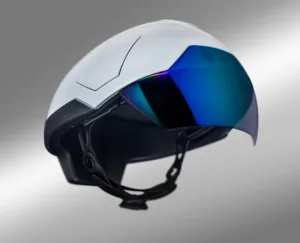One of the leaders in enterprise-focused augmented reality, Daqri, has acquired one of the leaders in holographic projection displays, Two Tree Photonics. Together, the two will pursue advanced helmets for AR, Head-up Displays (HUDs) for automobiles and other related applications for the combined technology.
Daqri has been developing their Smart Helmet for several years and has been shipping developer kits for two years now. “We were blown away by the technology that Two Trees was developing and the vision of the future that we both shared,” said Daqri CEO Brian Mullins on a recent call. “That is why we bought the company.” Financial details were not disclosed, but all of Two Trees Photonics 20 employees will now join the 350+ Daqri team.
Two Trees Photonics (2TP) CTO Dr. Jamieson Christmas will assume the same title with Daqri. “Having the resources of Daqri available to accelerate our R&D is a huge benefit of this acquisition,” said Christmas. “We are all very excited about the opportunities we see in front of us.”
Mullins and Christmas could not reveal too much about future products, but they are following the mantra of “AR everywhere” and think this leads not only to AR wearable devices and Head up Displays (HUDS), but the technology can enable advancements in smart headlights and 3D printing as well.
Two Trees Photonics is based on technology developed at Cambridge University in the UK that we have tracked for about 10 years. Light Blue Optics emerged perhaps 10 years ago and Alps Electric / Two Trees Photonics around 2010. Both focus on using LCOS displays as spatial light modulators with laser illumination. Instead of writing an image to the LCOS panel, a phase-based digital hologram is written to the imager. This hologram contains information like symbology for a HUD.
The beauty of this approach is that all of the light energy is directed only to the parts of the image that require light. In other words, no light is blocked or absorbed as in conventional LCD, LCOS or DLP imaging solutions. The result is very high efficiency. And, the LCOS panels can easily tolerate missing pixels – it just losses some efficiency. The phase-based hologram approach should allow delivery of brighter, more richly saturated images with higher contrast than other approaches – and with less power.
To create a full color image, requires the display of red, green and blue holograms in time sequence on the spatial light modulator. There may also be color break up issues, as with some slow-running single-chip DLP systems, so you need a fast spatial light modulator to get decent frame rates. Generating high quality holograms in realtime is challenging as well, which has been solved by using FPGAs from Altera.
A year ago, Two Trees Photonics came out of stealth mode revealing its first customer, Jaguar, and the use of the technology in the automotive HUD for the Range Rover Evoque. This is a red and green laser-based device allowing these two colors and all colors in between to be shown on the HUD. Sources suggest that there are over 150K of these HUDs in cars as of today.
But according to Dr. Christmas, by the time this announcement was made, they were well entrenched in next generation development efforts. Two Trees uses Alps Electric as their manufacturing partner, so the holographic HUD technology was transferred to them, to support production for Jaguar.
“Once this was complete, we refocused our efforts on developing full color, miniaturization of the system, and doing additional performance optimizations,” noted Dr. Christmas. While he was unable to be very specific on the improvements, he did say that RGB solutions are now available.
And now it gets interesting. Those who follow HUD technology know that there have been some attempts to add augmented reality to the HUD image, but these have only been prototypes so far. The Daqri CEO Brian Mullins, who was on the call with Dr. Christmas, hinted that the next generation HUD will indeed offer AR capabilities.
When we asked about the timing, he said, “This will happen in 2016, and in fact, you will see it soon.” This should be the first commercial car with a HUD with integrated AR.
So what does this mean exactly? It means that the HUD will use camera images of the road ahead and identify objects. This might be done by their geo-location, image recognition software or both. This means a turn arrow can be “locked” to the road, moving in the field of view as the turn approaches, growing bigger or smaller as well. In other words, the symbology won’t just float in space in front of the driver, but will consists of symbols locked or tagged to real world objects so that they become dynamic instead of static.
On the Daqri side, current developer kits are thought to use the waveguide and prism extracting technology developed by Lumis. While Mullins would not detail what a next generation helmet might contain, it is not hard to envision a solution that replaces the conventional microdisplay/projection source in the current helmet with an image source developed by 2TP. This image can still be coupled to the waveguide solution from Lumis, but would offer higher brightness and better power efficiency, we suspect.
Mullins acknowledged that such a solution was “one configuration, but there are others.” He would not elaborate, however. Look for new helmets to become available in the 12-24 month time frame, he said.
Mullins concluded by noting that they have raised $130M so far and feel they are well enough capitalized to execute the plans they have in the pipeline. – CC

